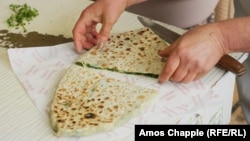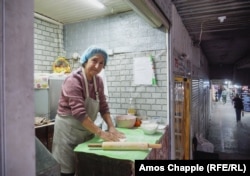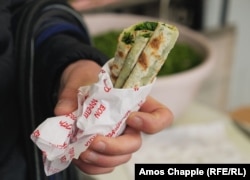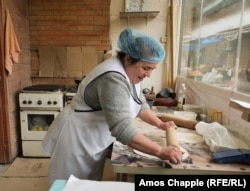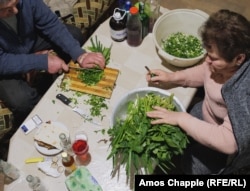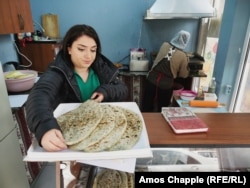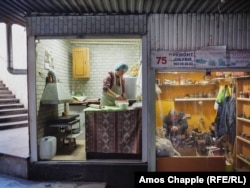YEREVAN -- In a tiny booth at the entrance to Yerevan’s Barekamutyn subway station, Lida Mkrtchian, a former teacher of Armenian literature, heaps shredded herbs and vegetables onto a circle of dough before pinching the package together and placing it on a smoking hot griddle.
"This is the taste of Shushi," she says, using the Armenian name for her hometown, a major city of the Nagorno-Karabakh region, which she was forced to flee in 2020.
A few steps deeper into the same subway entrance, another refugee from Nagorno-Karabakh wears traditional clothing from the region as she rolls out dough for her own version of the food known as “jingalov hats” that sell for 500 drams -- $1.25 each.
Before September 2020, when Azerbaijan began a series of military offensives to recapture land from ethnic Armenians in and around Nagorno-Karabakh, jingalov hats -- which translates roughly as “herb bread” -- were served in restaurants and featured on some fast-food menus in Armenia.
But over the past three years, the dish has become a street food of pizza-like popularity, with stalls set up by displaced Karabakh Armenians appearing in towns and villages across the country.
Ara Zada, the co-author of a book on Armenian cuisine, told RFE/RL the original recipe for jingalov hats calls for "26 herbs and greens" to be folded into a package of thin dough that is then pushed flat and cooked until lightly charred on both sides.
Today, Zada says around 17 different leafy greens are folded into the dough, along with splashes of oil, salt, and pepper. Typical nameable greens (many have no English translation) include spinach and cilantro, along with sharper ingredients such as mint, green onion, and sorrel. The filling can also include stinging nettle, which wilts and becomes harmless during the cooking process.
Many Karabakh Armenians add a squeeze of lemon or a zesty purple powder made from dried barberries for an acidic kick.
Ruzanna Tsaturian, a researcher at the Institute of Archaeology and Ethnography at Armenia's Academy of Sciences, says jingalov hats were first mentioned in texts around 200 years ago but were probably eaten by Karabakh Armenians long before that.
The dish is traditionally prepared in "early spring and autumn when the necessary wild herbs grow," the researcher said.
The dish was initially forged from hardship. In the lush countryside of Nagorno-Karabakh, locals who knew the right greens to pick could create a meal with only flour dough and foraged herbs when other foods were scarce.
In the 20th century, Tsaturian says the dish became more "like entertainment food, not a daily staple," but during the war fought between Azerbaijan and Armenia over control of Nagorno-Karabakh and subsequent shortages in the 1990s, Karabakh Armenians returned to the "forest bread" of their ancestors out of necessity.
In the postwar years, Tsaturian says the dish became an "iconic food, something like a postcard of Nagorno-Karabakh."
Amid the 2020 Nagorno-Karabakh war, stalls set up in central Yerevan selling jingalov hats attracted long queues, largely of Armenians wanting to show solidarity with Nagorno-Karabakh, the initiatives spawning several permanent businesses throughout Armenia.
In the summer of 2023, the dish reached new diners in the United States when the Michelin guide included a California restaurant that serves only jingalov hats on its prestigious food list -- the first Armenian restaurant in the United States to be given the honor.
In her booth at the entrance to the Yerevan subway, Lida Mkrtchian speaks with gratitude of the dish that has enabled her to build up a modest business from scratch.
"We came here with only the clothes on our backs," she said, while rolling out dough. "Now, I'm able to make something that people enjoy, and they bless me for it."
